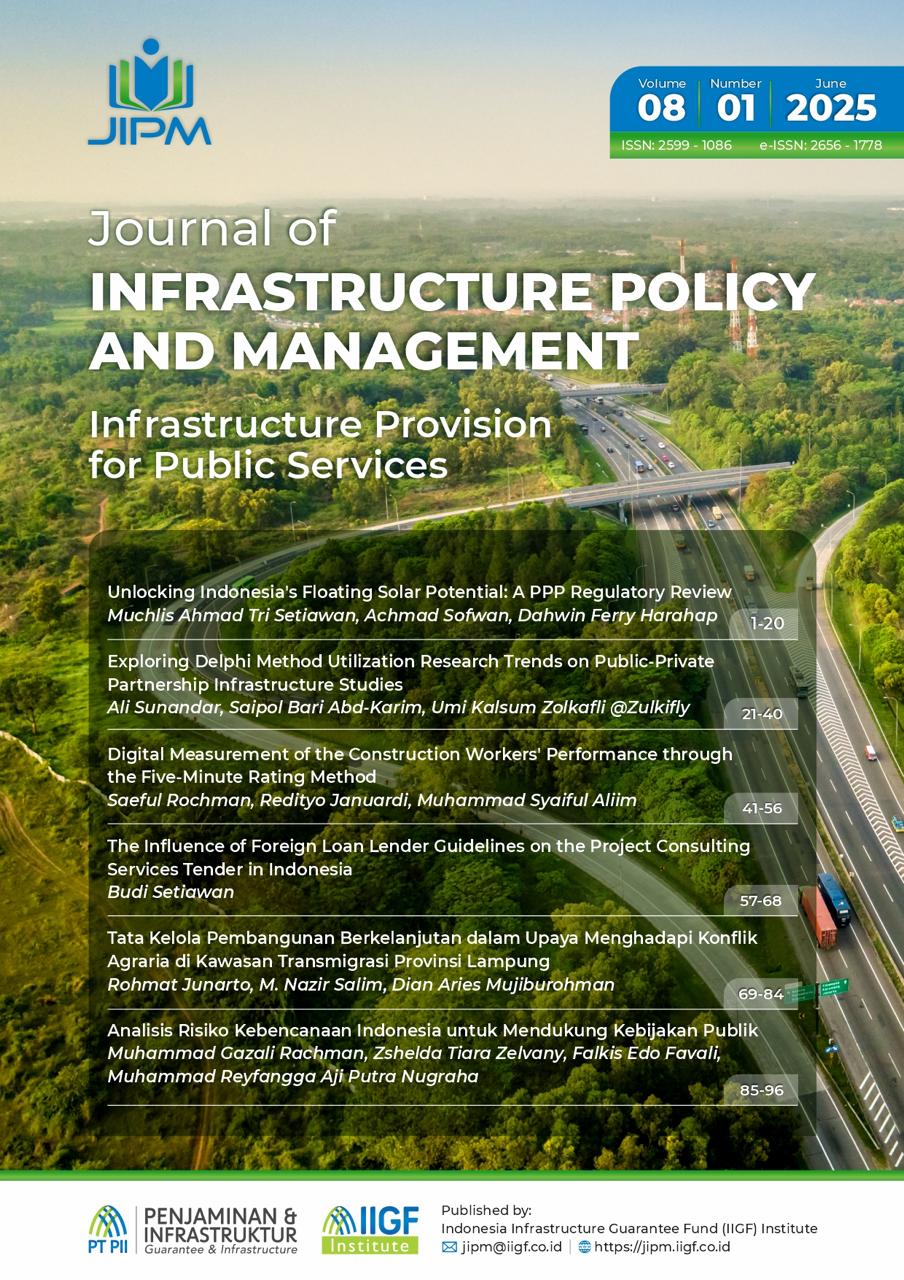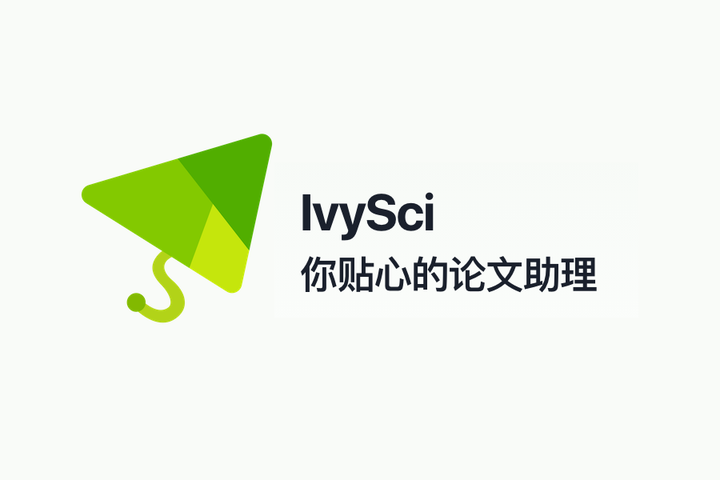Exploring Delphi Method Utilization Research Trends on Public-Private Partnership Infrastructure Studies
DOI:
https://doi.org/10.35166/jipm.v8i1.92Keywords:
Delphi Method, Infrastructure, PPP, PRISMA, SLRAbstract
This study seeks to explore the application of the Delphi method in Public-Private Partnership (PPP) infrastructure research over a ten-year span (2015-2024), with a focus on various characteristics such as the application of the Delphi method across different PPP infrastructure sectors, expert criteria for Delphi panels, the diverse use of consensus, and the execution of Delphi rounds. Employing a Systematic Literature Review (SLR) guided by the PRISMA framework, the study utilizes thematic categories alongside co-occurrence and co-authorship analyses to identify trends in the application of the Delphi method in PPP infrastructure studies. The review concentrates on literature indexed in two leading academic databases: Web of Science (WoS) and Scopus. The findings indicate that the use of the Delphi method has grown significantly in the past ten years within infrastructure PPP schemes, particularly in emerging countries driven by the increasing demand for infrastructure development. Research trends have highlighted a variety of characteristics of the Delphi method, including criteria for selecting experts, the number of expert participants, the number of Delphi rounds, and different approaches for achieving consensus or agreement. These findings offer valuable insights to inform and enhance the methodological rigor of future research utilizing the Delphi method in the context of PPP infrastructure.
References
Adu Gyamfi, T., Aigbavboa, C. O., & Thwala, W. D. (2024). Risk resources management influence on public–private partnership risk management in construction industry. Confirmatory factor analysis approach [Article]. Journal of Engineering, Design and Technology, 22(5), 1544-1569. https://doi.org/10.1108/JEDT-12-2021-0699
Albalate, D., & Bel-Piñana, P. (2019). The effects of public private partnerships on road safety outcomes [Article]. Accident Analysis and Prevention, 128, 53-64. https://doi.org/10.1016/j.aap.2019.03.015
AlKheder, S., Abdullah, W., & Al Sayegh, H. (2022). A socio-economic study for establishing an environment-friendly metro in Kuwait [Article]. International Journal of Social Economics, 49(5), 685-709. https://doi.org/10.1108/IJSE-04-2021-0210
Almarri, K. (2023). The value for money factors and their interrelationships for smart city public–private partnerships projects [Article]. Construction Innovation, 23(4), 815-832. https://doi.org/10.1108/CI-01-2022-0020
Alqahtani, D., Salman, B., & He, S. (2024). An Integrated Sustainability Assessment Framework for Public–Private Partnerships in Highway Projects [Article]. Journal of Transportation Engineering Part A: Systems, 150(7), Article 04024023. https://doi.org/10.1061/JTEPBS.TEENG-8189
Ameyaw, E. E., & Chan, A. P. C. (2016). A Fuzzy Approach for the Allocation of Risks in Public-Private Partnership Water-Infrastructure Projects in Developing Countries. Journal of Infrastructure Systems, 22(3), Article 04016016. https://doi.org/10.1061/(ASCE)IS.1943-555X.0000297
Ameyaw, E. E., & Chan, A. P. C. (2018). Modelling Risk Allocation Decisions in Public-Private Partnership Contracts using the Fuzzy Set Approach. https://doi.org/10.1108/9781787438682
Arijeloye, B. T., Aje, I. O., & Oke, A. E. (2024). Evaluating the key risk factors in PPP-procured mass housing projects in Nigeria: a Delphi study of industry experts [Article]. Journal of Engineering, Design and Technology, 22(1), 60-76. https://doi.org/10.1108/JEDT-08-2021-0403
Chan, A. P. C., Lam, P. T. I., Wen, Y., Ameyaw, E. E., Wang, S. Q., & Ke, Y. J. (2015). Cross-Sectional Analysis of Critical Risk Factors for PPP Water Projects in China. Journal of Infrastructure Systems, 21(1), Article 04014031. https://doi.org/10.1061/(ASCE)IS.1943-555X.0000214
Chan, D. W. M., Abdul Hadi Sadeq, D., Mohammed Fadhil, A., Cristofaro, M., & Sarvari, H. (2024). Barriers and solutions in adopting public–private partnerships in road transportation infrastructure projects for developing countries: results of a Delphi survey in Iran [Article]. Journal of Facilities Management, 22(4), 683-708. https://doi.org/10.1108/JFM-01-2022-0007
Chan, D. W. M., Sadeq, D. A. H., Fadhil, A. M., Cristofaro, M., & Sarvari, H. (2024). Barriers and solutions in adopting public-private partnerships in road transportation infrastructure projects for developing countries: results of a Delphi survey in Iran. Journal of Facilities Management, 22(4), 683-708. https://doi.org/10.1108/JFM-01-2022-0007
Chan, D. W. M., Sarvari, H., Husein, A. A. J. A., Awadh, K. M., Golestanizadeh, M., & Cristofaro, M. (2023). Barriers to Attracting Private Sector Investment in Public Road Infrastructure Projects in the Developing Country of Iran [Article]. Sustainability (Switzerland), 15(2), Article 1452. https://doi.org/10.3390/su15021452
Cheng, S., Yu, Y., Meng, F., Chen, J., Chen, Y., Liu, G., & Fan, W. (2023). Potential benefits of public–private partnerships to improve the efficiency of urban wastewater treatment [Article]. npj Clean Water, 6(1), Article 13. https://doi.org/10.1038/s41545-023-00232-2
De Paula, P. V., Marques, R. C., & Gonçalves, J. M. (2023). Public-Private Partnerships in Urban Regeneration Projects: A Review [Article]. Journal of Urban Planning and Development, 149(1), Article 04022056. https://doi.org/10.1061/JUPDDM.UPENG-4144
Eyiah-Botwe, E., Aigbavboa, C. O., & Thwala, W. D. (2020a). Curbing PPP construction projects' failure using enhanced stakeholder management success in developing countries. Built Environment Project and Asset Management, 10(1), 50-63. https://doi.org/10.1108/BEPAM-01-2018-0035
Eyiah-Botwe, E., Aigbavboa, C. O., & Thwala, W. D. (2020b). Curbing PPP construction projects’ failure using enhanced stakeholder management success in developing countries [Article]. Built Environment Project and Asset Management, 10(1), 50-63. https://doi.org/10.1108/BEPAM-01-2018-0035
Fathi, M., & Shrestha, P. P. (2023a). Identification of Critical Success and Risk Factors for Public-Private Partnership Highway Projects [Article]. Journal of Legal Affairs and Dispute Resolution in Engineering and Construction, 15(1), Article 04522051. https://doi.org/10.1061/(ASCE)LA.1943-4170.0000587
Fathi, M., & Shrestha, P. P. (2023b). Public-Private Partnership Contract Framework Development for Highway Projects: A Delphi Approach [Article]. Journal of Legal Affairs and Dispute Resolution in Engineering and Construction, 15(1), Article 04522046. https://doi.org/10.1061/(ASCE)LA.1943-4170.0000575
Gharaee, H., Dewey, R. S., Gholami, A. H., & Azami-Aghdash, S. (2023). Developing a public-private partnership framework for managing the adverse health effects of environmental disaster (a case study of Lake Urmia - Iran) [Article]. Journal of Water and Health, 21(2), 251-260. https://doi.org/10.2166/wh.2023.239
Giti, D. M., K'Akumu, O. A., & Ondieki, E. O. (2020). Enhanced role of private sector through public private partnerships in low income urban housing in Kenya [Article]. Journal of Financial Management of Property and Construction, 25(2), 293-312. https://doi.org/10.1108/JFMPC-07-2019-0057
Glumac, B., Han, Q., Schaefer, W., & van der Krabben, E. (2015). Negotiation issues in forming public-private partnerships for brownfield redevelopment: Applying a game theoretical experiment. Land Use Policy, 47, 66-77. https://doi.org/10.1016/j.landusepol.2015.03.018
Gough, D., Oliver, S., & Thomas, J. (2017). An Introduction to Systematic Reviews (2nd edition ed.). Sage Publications Ltd.
Guo, X., Chen, B., & Feng, Y. (2022). Public-Private Partnership Transportation Investment and Low-Carbon Economic Development: An Empirical Study Based on Spatial Spillover and Project Characteristics in China [Article]. Sustainability (Switzerland), 14(15), Article 9574. https://doi.org/10.3390/su14159574
Han, Q., Zhu, Y., Ke, G. Y., & Hipel, K. W. (2019). Public private partnership in brownfield remediation projects in China: Identification and structure analysis of risks [Article]. Land Use Policy, 84, 87-104. https://doi.org/10.1016/j.landusepol.2019.01.034
Harie, Y., Gautam, B. P., & Wasaki, K. (2023). Computer Vision Techniques for Growth Prediction: A Prisma-Based Systematic Literature Review. Applied Sciences, 13(9). https://doi.org/10.3390/app13095335
Hijriyah, L., Alias, A., & Mohd Sahabuddin, M. F. (2023). Exploring walkability research trends based on systematic literature review (SLR) by applying PRISMA. Open House International, 49(1), 63-121. https://doi.org/10.1108/ohi-02-2023-0031
Ismail, S. N., Ramli, A., & Aziz, H. A. (2021a). Research trends in mining accidents study: A systematic literature review. Safety Science, 143. https://doi.org/10.1016/j.ssci.2021.105438
Ismail, S. N., Ramli, A., & Aziz, H. A. (2021b). Influencing factors on safety culture in mining industry: A systematic literature review approach. Resources Policy, 74. https://doi.org/10.1016/j.resourpol.2021.102250
Jafari Ramiani, A., Sarvari, H., Chan, D. W. M., Nassereddine, H., & Lotfata, A. (2024). Critical success factors for private sector participation in accomplishing abandoned public sports facilities projects in Iran [Article]. International Journal of Construction Management, 24(6), 586-600. https://doi.org/10.1080/15623599.2022.2147647
Jayasuriya, S., Zhang, G. M., & Yang, R. J. (2024). Towards successful economic infrastructure partnership project delivery through effective stakeholder management. Transportation Research Interdisciplinary Perspectives, 26, Article 101173. https://doi.org/10.1016/j.trip.2024.101173
Kaletnik, G., & Lutkovska, S. (2021). Implementation of public-private partnership models in the field of ecological modernization of the environmental safety system [Article]. European Journal of Sustainable Development, 10(1), 81-89. https://doi.org/10.14207/ejsd.2021.v10n1p81
Kharlamov, A. (2023). Do Emerging Markets Succeed in Implementing Sustainability Principles in Infrastructure Finance? Evidence from Public-Private Partnerships in Russia [Article]. Journal of Corporate Finance Research, 17(1), 17-26. https://doi.org/10.17323/j.jcfr.2073-0438.17.1.2023.17-26
Kouton, J., Sanogo, W., & Djomgoue, N. (2023). Risk allocation in energy infrastructure PPPs projects in selected African countries: does institutional quality, PPPs experience and income level make a difference? [Article]. Economic Change and Restructuring, 56(1), 537-580. https://doi.org/10.1007/s10644-022-09433-0
Kristiana, R., & Sunandar, A. (2020). Identifikasi Risiko Fase Operasional Dan Pemeliharaan Proyek Stadion Equestrian Jakarta Berbasis Pendekatan Public Private Partnership. Fondasi: Jurnal Teknik Sipil, 9(2), 127-137. https://doi.org/http://dx.doi.org/10.36055/jft.v9i2.5932
Kukah, A. S. K., Badu, E., Owusu-Manu, D. G., & Edwards, D. J. (2023). Motivations for engaging in PPP power projects in Ghana: comparison of the public and private sectors [Article]. International Journal of Energy Sector Management, 17(1), 187-205. https://doi.org/10.1108/IJESM-09-2021-0002
Kukah, A. S. K., Owusu-Manu, D. G., Badu, E., Edwards, D. J., & Asamoah, E. (2024). Fuzzy quantitative risk allocation model (FQRAM) to guide decision-making on risk allocation in Ghanaian public-private partnership (PPP) power projects [Article]. Journal of Financial Management of Property and Construction, 29(1), 83-114. https://doi.org/10.1108/JFMPC-10-2022-0055
Kumar, A. (2023). Systematic Literature Review (SLR). In: Meta-analysis in Clinical Research: Principles and Procedures. Springer Nature. https://doi.org/https://doi.org/10.1007/978-981-99-2370-0_2
Kuru, K., & Artan, D. (2024). Information Requirements for Effective Risk and Contract Management in Public-Private Partnerships: A Delphi Approach [Article]. Journal of Design and Built Environment, 24(1), 53-75. https://www.scopus.com/inward/record.uri?eid=2-s2.0-85202459754&partnerID=40&md5=e3768c7cd1095a1f2ea61b527f608b5d
Li, Y., & Wang, X. Y. (2018). Risk assessment for public-private partnership projects: using a fuzzy analytic hierarchical process method and expert opinion in China. Journal of Risk Research, 21(8), 952-973. https://doi.org/10.1080/13669877.2016.1264451
Mahboubi Niazmandi, M., Sedaeesoula, R., Lari, S., & Moussavi, P. (2024). An integrated risk and productivity assessment model for public–private partnership projects using fuzzy inference system [Article]. Decision Analytics Journal, 10, Article 100376. https://doi.org/10.1016/j.dajour.2023.100376
Malik, S., & Kaur, S. (2020). Challenges of financing infrastructure deficits through PPPs: Lessons from global experience [Article]. Indian Journal of Finance, 14(10-11), 8-23. https://doi.org/10.17010/ijf/2020/v14i10-11/155968
Mansilla, P., & Vassallo, J. M. (2020). Innovative infrastructure fund to ensure the financial sustainability of PPP projects: The case of Chile [Article]. Sustainability (Switzerland), 12(23), 1-21, Article 9965. https://doi.org/10.3390/su12239965
Moher, D., Liberati, A., Tetzlaff, J., Altman, D. G., & Group, P. (2009). Preferred reporting items for systematic reviews and meta-analyses: the PRISMA statement. BMJ, 339, b2535. https://doi.org/10.1136/bmj.b2535
Moradi Shahdadi, L., Aminnejad, B., Sarvari, H., & Chan, D. W. M. (2023). Determining the Critical Risk Factors of Implementing Public–Private Partnership in Water and Wastewater Infrastructure Facilities: Perspectives of Private and Public Partners in Iran [Article]. Buildings, 13(11), Article 2735. https://doi.org/10.3390/buildings13112735
Nahdi, M., Widayati, N., Wibowo, M. A., Sari, E. M., Tamin, R. Z., & Thohirin, A. (2024). Examining Solicited Projects of Public–Private Partnerships (PPP) in the Initiative of Indonesian Government. Buildings, 14(6), 1-17. https://doi.org/10.3390/buildings14061870
Ojiako, U., Chipulu, M., Almeile, A. M., Ika, L., Bashir, H., Marshall, A., & Alraeesi, E. J. H. (2023). Variations in critical success factors of PPP-procured construction projects over lifecycle phases. PRODUCTION PLANNING & CONTROL. https://doi.org/10.1080/09537287.2023.2294310
Page, M. J., McKenzie, J. E., Bossuyt, P. M., Boutron, I., Hoffmann, T. C., Mulrow, C. D., Shamseer, L., Tetzlaff, J. M., Akl, E. A., Brennan, S. E., Chou, R., Glanville, J., Grimshaw, J. M., Hrobjartsson, A., Lalu, M. M., Li, T., Loder, E. W., Mayo-Wilson, E., McDonald, S.,…Moher, D. (2021). The PRISMA 2020 statement: An updated guideline for reporting systematic reviews. J Clin Epidemiol, 134, 178-189. https://doi.org/10.1016/j.jclinepi.2021.03.001
Ramiani, A. J., Sarvari, H., Chan, D. W. M., Nassereddine, H., & Lotfata, A. (2024). Critical success factors for private sector participation in accomplishing abandoned public sports facilities projects in Iran. International Journal of Construction Management, 24(6), 586-600. https://doi.org/10.1080/15623599.2022.2147647
Rarasati, A. D., Trigunarsyah, B., & Too, E. (2014). The Opportunity for Implementing Islamic Project Financing to the Indonesian Infrastructure Development. In The Developing Role of Islamic Banking and Finance: From Local to Global Perspectives (pp. 103-116). https://doi.org/10.1108/s1569-3759(2014)0000095015
Sahoo, P., Saraf, P. K., & Uchil, R. (2022). Identification of critical success factors for leveraging Industry 4.0 technology and research agenda: a systematic literature review using PRISMA protocol. Asia-Pacific Journal of Business Administration. https://doi.org/10.1108/apjba-03-2022-0105
Sihombing, L., Latief, Y., Rarasati, A. D., & Wibowo, A. (2018). Developing a toll road financing model with a hybrid of deep discount project bonds and land leases in Indonesia [Article]. International Journal of Civil Engineering and Technology, 9(6), 1310-1323. https://www.scopus.com/inward/record.uri?eid=2-s2.0-85049593480&partnerID=40&md5=58060865b5b826f1967477ec78dbd105
Smith, V., Devane, D., Begley, C. M., & Clarke, M. (2011). Methodology in conducting a systematic review of systematic reviews of healthcare interventions. BMC Med Res Methodol, 11(1), 15. https://doi.org/10.1186/1471-2288-11-15
Sunandar, A., Abd Karim, S. B., & Zolkafli, U. K. (2024). Exploring Risk Aspects in Public-Private Partnership Infrastructure Research: A Bibliometric Analysis. Journal of Infrastructure Policy and Management (JIPM), 7(1), 27-42. https://doi.org/https://doi.org/10.35166/jipm.v7i1.45
Sunandar, A., & Indiyati, D. (2023). The Influence of Planning and Preparation Stage on the Success of Public Private Partnership Local Government Scheme (KPDBU) Availability Payment in Indonesia. Proceedings of the International Conference on Sustainable Collaboration in Business, Technology, Information, and Innovation (SCBTII 2023), 93-112. https://doi.org/10.2991/978-94-6463-292-7_7 (Advances in Economics, Business and Management Research)
Surachman, E. N., Handayani, D., Suhendra, M., & Prabowo, S. (2020). Critical Success Factors on PPP Water Project in a Developing Country: Evidence from Indonesia [Article]. Journal of Asian Finance, Economics and Business, 7(10), 1071-1080. https://doi.org/10.13106/jafeb.2020.vol7.no10.1071
Tamošaitienė, J., Sarvari, H., Chan, D. W. M., & Cristofaro, M. (2021). Assessing the barriers and risks to private sector participation in infrastructure construction projects in developing countries of Middle East [Article]. Sustainability (Switzerland), 13(1), 1-20, Article 153. https://doi.org/10.3390/su13010153
The World Bank Group, A., EBRD, IDB, and IsDB. (2016). The APMG Public-Private Partnership (PPP) Certification Guide. The World Bank Group. https://ppp-certification.com/pppguide/download
Thompson, J. (2022). A Guide to Abductive Thematic Analysis. The Qualitative Report. https://doi.org/10.46743/2160-3715/2022.5340
Tian, B., Wang, Z., Li, C., & Fu, J. (2023). Can relational governance improve sustainability in public-private partnership infrastructure projects? An empirical study based on structural equation modeling [Article]. Engineering, Construction and Architectural Management, 30(1), 19-40. https://doi.org/10.1108/ECAM-04-2021-0333
Wang, B., Shi, N., Wang, F., & Nie, X. (2019). Risk evaluation of water conservancy in a public-private partnership project based on grey fuzzy theory [Article]. Revista Internacional de Contaminacion Ambiental, 35(Special Issue 1), 111-121. https://doi.org/10.20937/RICA.2019.35.esp01.11
Wu, Y. N., Song, Z. X., Li, L. W. Y., & Xu, R. H. (2018). Risk management of public-private partnership charging infrastructure projects in China based on a three-dimension framework. Energy, 165, 1089-1101. https://doi.org/10.1016/j.energy.2018.09.092
Yescombe, E. R., & Farquharson, E. (2018). Public-Private Partnership for Infrastructure Principles of Policy and Finance (Second Edition ed.). Elsevier Ltd. https://doi.org/https://doi.org/10.1016/C2011-0-04354-5
Zarghani, M., Nemati-Anaraki, L., Sedghi, S., Chakoli, A. N., & Rowhani-Farid, A. (2024). Design and validation of a conceptual model regarding impact of open science on healthcare research processes. BMC Health Serv Res, 24(1), 309. https://doi.org/10.1186/s12913-024-10764-z
Zhang, H., Liu, G. W., Han, Q. Y., & Chen, G. (2023). Mapping the Barriers of Utilizing Public Private Partnership into Brownfield Remediation Projects in the Public Land Ownership. LAND, 12(1), Article 73. https://doi.org/10.3390/land12010073
Zhao, H., Cheng, X., Gao, J., & Yu, G. (2023). A study on risk sharing of smart city PPP projects based on EW-G1 and TOPSIS-UT: a case study in China [Article]. Kybernetes. https://doi.org/10.1108/K-05-2023-0824
Zhao, H., Ma, S., & Bu, Z. (2020). Constructing a Risk-Sharing Framework for Sponge City PPP Projects from the Perspective of the Individual Participant [Article]. Advances in Civil Engineering, 2020, Article 8832664. https://doi.org/10.1155/2020/8832664
Downloads
Published
Issue
Section
License
Copyright (c) 2025 Journal of Infrastructure Policy and Management (JIPM)

This work is licensed under a Creative Commons Attribution-ShareAlike 4.0 International License.















